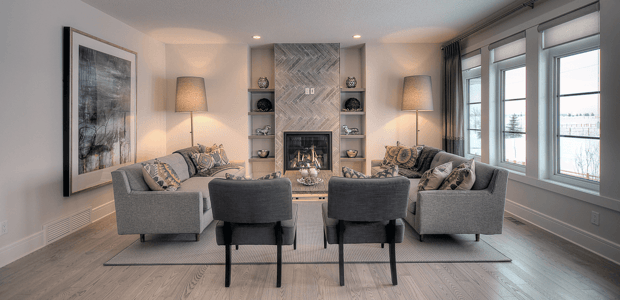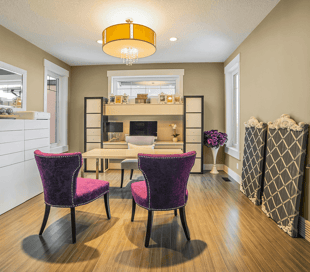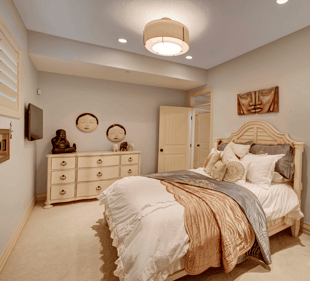 There are so many ways to decorate your home with paint colours, fabrics, furniture styles, and just the right amount of décor items here and there. But what do we do about those walls? Artwork has been a long-standing tradition in our homes, but the way artwork is hung has definitely progressed over the years. We are no longer simply lining it all up in a row, or placing the standard oversized painting over the sofa. Today we're hanging art in such a way that we are making art out of the artwork.
There are so many ways to decorate your home with paint colours, fabrics, furniture styles, and just the right amount of décor items here and there. But what do we do about those walls? Artwork has been a long-standing tradition in our homes, but the way artwork is hung has definitely progressed over the years. We are no longer simply lining it all up in a row, or placing the standard oversized painting over the sofa. Today we're hanging art in such a way that we are making art out of the artwork.
The Mood Board
If you know someone who's any kind of designer — interior, graphic, industrial — you may have heard them use the term, “mood board”. This is a collage of sorts containing all kinds of inspiring images, textures, and colours assembled to inspire a style or theme. This type of concept can be used as art on your walls.
Naturally, the mood board is made up of plenty of non-uniform items. Create your display to balance framed photos with pieces of sculpture. Incorporate fabrics, and utilize varying shapes. Whatever you do, be sure to read up on space and balance to get this right — the spaces between items should be even, heavier items balanced with lighter items, and so forth.
This concept is best used on a wall with no other real purpose, but can also be used to enhance a niche space. Does your home have an open-to-below staircase? A mood board can be displayed on the wall you face when ascending the stairs. Perhaps your bedroom has a cozy reading corner; display a mood board above your lamp table or above your chair, whichever has the larger space.
Have fun with this concept. Experiment until you feel it blends well with the rest of the room.
 Unique Objects as Art
Unique Objects as Art
Not every piece of art needs to be a picture in a frame. If you’ve spent any time in show homes recently you’ll notice designers are starting to use more sculpture and unexpected shapes on walls rather than the standard rectangular picture frame. These may take a bit more effort to hang, but their impact can be quite striking.
Depending on the piece you're hanging, you can accent a certain part of a room or make it the focal point. Either way, this surprising effect really elevates the ambiance of the space.
Balance Texture and Contrast
When placing artwork over a textured or brightly coloured wall, be sure the artwork doesn’t fight with its home. If placing artwork on a mantle above a stone-wrapped fireplace, you don’t want the artwork itself to be overly busy. Keep it simple with plenty of white space, and the artwork will enhance the look of your stone.
Equally, if you are placing art on a boldly coloured wall, the work itself shouldn’t contain bold colours. For example, artwork you’d place over a navy blue wall could be white or beige, softening the impact of the wall and giving the eye a place to rest.
Use Large Pieces Sparingly
Large-scale artwork can have a massive impact on a room, but you don’t want to have these behemoths all over the place. Stick to one large piece per space, and judge based on the scale of the room. You won’t want to do this in secondary bedrooms or a smaller den, but rather in open-to-below spaces, stairwells, or in the master bedroom.
 Symmetry or Not-So-Symmetry
Symmetry or Not-So-Symmetry
Most human beings are attracted to symmetry; our brains are wired to find comfort in pattern and, as such, symmetry calms us down. If things being helter-skelter stresses you out, use your artwork to bring balance to the space by creating symmetric displays on your walls.
This doesn’t necessarily mean hanging everything in a perfect, single row. Hanging multiple pieces of art in varying heights is a great way to create interest while duplicating the exact layout either beside, opposite, or on two walls in a corner.
Additionally, opting for just a little asymmetry can add an interesting effect; try hanging your art piece slightly off-centre from the furniture below, and see how you might like the more eclectic feel.
Scale
Scale is also very important when displaying artwork. This doesn’t mean fill every square inch of wall with paintings, but rather fit the artwork to the room in a general sense. You’ll still need empty space around the artwork in order for the art to remain appealing, but place smaller art in a smaller space and larger art in open spaces. It would look rather odd to have a tiny painting on a massive wall.
There are many ways to display artwork in your home, and these are just a few. The idea is to experiment with not only where it's displayed, but the type of artwork you choose. What you display and how you display it has a great impact on your overall home décor.
Artwork often works well as the statement piece of a room, as well. Consider our advice on how to design a room around a statement piece to really nail your design plans.




